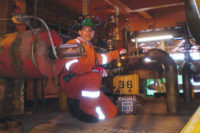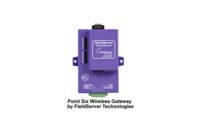Traditionally, these systems have been fixed, hard-wired systems. The sensors are installed at fixed locations and wires are run, either in conduits or buried underground, to the controller. These systems are reliable and effective, but they are costly. Because of this, the oil and gas industry continues to look for technology that not only will keep workers safe and meet regulatory requirements, but also improve productivity and return on investment. To meet these needs, many organizations are now deploying wireless gas-detection systems.
Wireless systems monitor midstream operations
Midstream operations are a particularly good application for a wireless gas detection monitoring system. Tank farms, for example, often need fence line monitoring that will detect H2S gas around the perimeter, or footprint of the facility. Although humans can smell levels of H2S gas that are completely safe, any “nuisance smell” could raise concerns. It’s best to detect and correct these situations before they become real problems.
Traditional, fixed-wired systems are often used in these applications, but there are several drawbacks. First, it’s very costly to install a fixed-wired system. Installing a fixed system requires running thousands of feet of cable by skilled electricians. It may also require digging hundreds of feet of trenches to run cables underground from sensors to the controller. When the cable is broken or cut, or there’s a plant turnaround, the trenches must be re-dug, the cables pulled, and the process re-initiated at the new location.
Second, wired systems require that personnel be on site to monitor the system. The reason for this is that most controllers for wired systems are not equipped for remote monitoring and control. This lack of sophistication makes them unsuitable for operations that do not have a full-time staff.
In recent years, wireless detection systems have become intrinsically safe and attractive replacements for traditional fixed-wired or hard-wired systems. Wireless mesh systems can be installed and fully operational in 30 minutes. What’s more, if one of the sensors goes offline, the network reconfigures itself and continues to operate. Other benefits include real-time continuous data collection, less time making manual readings, and reduced travel and fuel costs because data can be transmitted from remote locations.
Wireless systems consist of one or more monitor units, like the one shown in Figure 1, and a controller unit. The monitor units are very small, measuring 10.5 in. x 3.7 in. x 2.1 in. (26.5 cm x 9.5 cm x 5.5 cm) and weighing only 1.3 pounds (0.6 kg). This means that they are very easily transported to wherever they are to be installed, and once installed, they need no wiring. Once you turn them on, they establish communications with the controller, and you’re up and running.
A single controller can accept inputs from up to 24 monitor units, provides alarm outputs, and the user interface for the system. What’s different about this controller, when compared to controllers for wired systems, is that you can access this controller via the Internet. This means that the system can be monitored remotely, making it suitable for unmanned midstream operations.
Because the controller is accessible remotely, the data can be made available to those outside the company, where appropriate. For example, a company might choose to make the sensor data available to local fire/hazmat organizations that may have to respond to alarms. Having this data available would help them prepare to respond to an emergency.
Wireless costs less, is scalable
“While accessibility is important for monitoring midstream operations, lower cost is still #1. Installing a fixed, wired system with eight sensors could cost up to $45,000 when you factor in equipment costs, cabling costs, and installation labor,” According to Matt Netsch, director of marketing and sales for Teksolv, Newark, Del., a company that provides safety, health, environmental industrial hygiene and rescue and emergency stand-by services. “A comparable wireless system might cost half that.”
In addition, wireless systems are much more scalable than fixed, wired systems. For example, we recently installed a fence-line monitoring system at a refinery construction site. When the footprint of that site changed, we were able to quickly and easily reconfigure the fence-line monitoring system by simply adding, removing or moving the sensors. No wiring changes were needed.
A key advantage to this generation of wireless detection monitors is the ability to broadcast alarms and data in real time. Advances in secure Internet access and the ability to get data onto the Internet from almost anywhere have made these real-time interactions possible. Such access to data has now become an operational advantage to globally distributed safety teams as well as multinational firms. This provides several advantages, including allowing wireless system users to engage remote industrial hygienists, safety experts or plant managers in the same way doctors working in remote locations can work with medical-center specialists.
A total solution
Perhaps one of the most innovative examples of a wireless fence-line monitoring system is at the Total Petrochemicals tank farm in Port Arthur, Texas. In 2007, Total headquarters issued a directive that mandated around-the-clock monitoring of storage tanks that contain potentially explosive chemicals with low LELs (lower explosive limits). They were already using wireless sensors at the fence line for monitoring odors that might impact nearby neighborhoods.
Based on their experience with those sensors, they believed that they could also use wireless sensors to implement this new monitoring system. The final system design includes 49 separate sensors including sensors for H2S, SO2, LEL, oxygen, and a photoionization detector (PID) for volatile organic compounds (VOCs) or hydrocarbons.
One of the wireless system’s biggest advantages also proved to be one of its biggest challenges. Because wireless systems are wireless, the monitor units are battery-powered, and the batteries must be replaced periodically. This challenge was met by developing a solar-panel solution that replaced the batteries in the monitors while maintaining strict Class 1, Division 2 intrinsic-safety requirements. This solar-power solution can power the monitors for up to 14 days without sunshine.
Summary
Today’s wirelessly connected monitoring systems for the detection of dangerous atmospheric gases and compounds provide a range of benefits for industrial and environmental companies. Rapid deployments with flexible and portable detection implementations, easy setup and reliable remote monitoring are key benefits that allow organizations to provide unsurpassed worker and responder safety, and comply with industry regulations. Wireless gas detection systems can also provide significant cost-savings due to the speed of installation and lack of cabling requirements. The capability of broadcasting alarms in real time gives safety managers unprecedented control of detection data, and software solutions provide new ways to view and aggregate data from multiple sensor sources.



